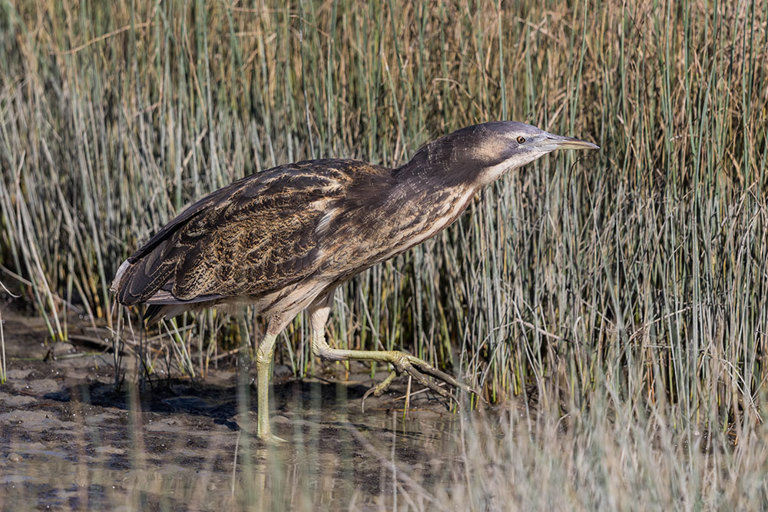Australasian Bittern (matuku-hūrepo)
The Australasian Bittern (matuku-hūrepo) is one of a small number of native wetland predators that ensure a healthy biodiversity in our wetlands ecosystem. This magnificent but secretive bird was once seen congregating in large flocks, but are now only rarely seen, usually as solitary figures. Bittern are a Threatened (Nationally Critical) species and only 250-1,000 mature individuals remain.
Matuku are wetland birds, eating eels, frogs, fish and insects. They are 70cm in height and have a distinctive “freeze” stance when disturbed, whilst their brown-grey plumage enables them to camouflage into the reeds.
New Zealand’s native bittern populations have been decimated by wetland drainage and habitat clearance, whilst pest predators such as rats, stoats and cats eat their eggs on the nest. A national focus on wetland restoration and rejuvenation is needed to ensure the survival of this fragile but important habitat and the wildlife it supports.
Bittern facts
- Secretive bird in the heron family with brown, beige and grey plumage
- 70cm in height. Distinctive “freeze” stance when disturbed
- Threatened – Nationally Critical – approx. 250-1000 mature individuals remaining
- Large flocks seen in the past, now lucky to see one bird
- During breeding season (Spring) males produce a “boom” sound to attract females and to guard their territory from other males. The male defends the territory while the female incubates the eggs and feeds the hatchlings.
 Australasian Bittern In Wetland (Photo Imogen Warren Photography)
Australasian Bittern In Wetland (Photo Imogen Warren Photography)
 Australasian Bittern By Water (Photo Imogen Warren Photography)
Australasian Bittern By Water (Photo Imogen Warren Photography)
 Australasian Bittern Freeze Stance (Photo Imogen Warren Photography)
Australasian Bittern Freeze Stance (Photo Imogen Warren Photography)
 Australasian Bittern Freeze Closeup (Photo Imogen Warren Photography)
Australasian Bittern Freeze Closeup (Photo Imogen Warren Photography)

How you can help
Make conscious choices to protect the fragile wetlands ecosystem:
- Leave nesting birds alone
- Use available access ways to get to the beach
- Only take dogs to areas that allow them and keep them under control
- If you come across wildlife put your dog on a lead and lead it away
Effective pest control on your property will also help. By trapping outside wetlands, a larger buffer zone is created to protect the areas where bitterns are vulnerable and helping Aotearoa towards its collective goal of being Predator Free by 2050.
- Start small with one or two rat traps
- Use a trap box to minimise harm to pets and children
- Form a trapping group with neighbours and friends
- Find inspiration from within our community by connecting with local groups like Tiakina Whangārei. Go to: tiakinawhangarei.co.nz to find out more and get involved.
- For further information on effective pest control, visit our Pest Control Hub
If you see a bittern
Please contact the Northland Regional Council to report a sighting by completing the encounter form here, or below, or call us on 0800 002 004.
The NRC has statutory obligations to monitor and report on threatened species and to maintain indigenous biodiversity.
Data from reported sightings will help NRC and other agencies to understand the species presence in Te Taitokerau.
Your personal details will not be shared when you report a sighting. No data will be publicly available online.
(Hold tight, we're loading the form).

